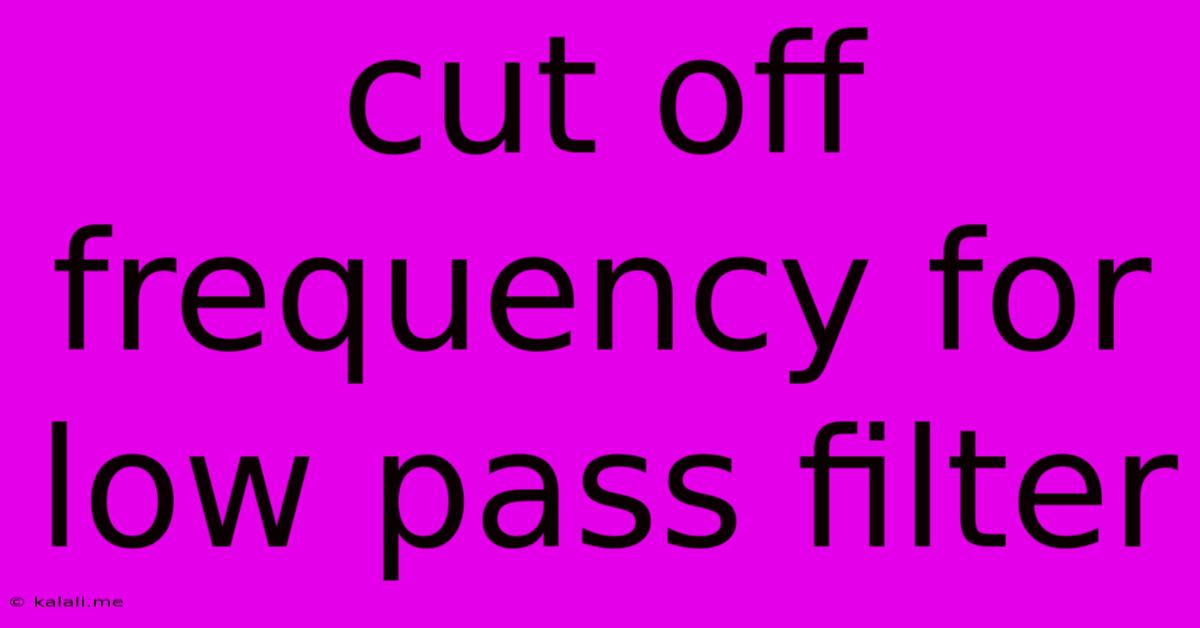Cut Off Frequency For Low Pass Filter
Kalali
May 21, 2025 · 3 min read

Table of Contents
Understanding Cut-Off Frequency in Low-Pass Filters
Meta Description: This article provides a comprehensive guide to understanding cut-off frequency in low-pass filters, explaining its significance, calculation methods, and practical applications in various signal processing scenarios. Learn how to determine the -3dB point and its impact on filter design.
Low-pass filters are fundamental components in signal processing, used to allow signals below a specific frequency to pass through while attenuating signals above that frequency. A crucial parameter defining the performance of a low-pass filter is its cut-off frequency (f<sub>c</sub>), also known as the corner frequency. This article delves into the concept of cut-off frequency, explaining its significance, how it's determined, and its role in filter design.
What is Cut-Off Frequency?
The cut-off frequency represents the point at which the filter's output power is reduced to half its maximum value. In decibels (dB), this corresponds to a -3dB attenuation. This means that frequencies below f<sub>c</sub> are passed with minimal attenuation, while frequencies above f<sub>c</sub> experience increasing attenuation. The transition isn't abrupt; there's a gradual roll-off region where the attenuation increases progressively.
The exact shape of this roll-off is determined by the filter's order. Higher-order filters generally provide steeper roll-offs, meaning a more rapid attenuation of frequencies above f<sub>c</sub>. First-order filters exhibit a gentle slope, while higher-order filters (second-order, third-order, etc.) show progressively steeper slopes.
Calculating Cut-Off Frequency
The calculation of cut-off frequency depends on the filter's design. Different filter topologies (like Butterworth, Chebyshev, Bessel) have different transfer functions, leading to variations in the cut-off frequency calculation. However, the general principle remains the same: finding the frequency at which the output power is halved.
For simple RC (Resistor-Capacitor) low-pass filters:
The cut-off frequency is determined by the resistor (R) and capacitor (C) values:
f<sub>c</sub> = 1 / (2πRC)
Where:
- f<sub>c</sub> is the cut-off frequency in Hertz (Hz)
- R is the resistance in Ohms (Ω)
- C is the capacitance in Farads (F)
This formula provides a straightforward way to calculate the cut-off frequency for basic RC filters. More complex filter designs require more sophisticated mathematical tools.
Significance of Cut-Off Frequency
The cut-off frequency is paramount in filter design because it directly impacts the filter's performance. It defines the boundary between the passband (frequencies below f<sub>c</sub>) and the stopband (frequencies above f<sub>c</sub>). Several aspects are influenced by f<sub>c</sub>:
- Bandwidth: The bandwidth of a low-pass filter is directly related to its cut-off frequency. A higher f<sub>c</sub> means a wider bandwidth.
- Signal Integrity: Choosing the right f<sub>c</sub> is crucial for preserving the desired signal components while rejecting unwanted noise or interference. An improperly chosen f<sub>c</sub> can lead to signal distortion or loss of important information.
- Filter Design Choices: The selection of f<sub>c</sub> often influences the choice of filter topology (Butterworth, Chebyshev, Bessel, etc.) as each topology offers different trade-offs between roll-off steepness, passband ripple, and phase response.
Practical Applications
Low-pass filters with carefully chosen cut-off frequencies are ubiquitous in various applications:
- Audio Processing: Removing high-frequency noise or hiss from audio signals.
- Image Processing: Smoothing images by attenuating high-frequency components responsible for sharp edges and noise.
- Telecommunications: Filtering out unwanted signals and interference in communication systems.
- Control Systems: Shaping the frequency response of control loops to achieve desired stability and performance.
Conclusion
The cut-off frequency is a critical parameter for understanding and designing low-pass filters. Understanding its calculation and significance is essential for anyone working with signal processing, ensuring optimal filter performance in various applications. Choosing the appropriate cut-off frequency depends on the specific application requirements and desired filter characteristics. By carefully selecting the components and filter topology, engineers can achieve the desired balance between signal fidelity and noise rejection.
Latest Posts
Latest Posts
-
How To Turn Off Alarm In House
May 21, 2025
-
Gatwick Airport To Travelodge Gatwick Central
May 21, 2025
-
My Son Sleeps All Day And Is Up All Night
May 21, 2025
-
Having A Good Opinion Of Ones Character
May 21, 2025
-
Toilet Not Flushing Properly Water Rises
May 21, 2025
Related Post
Thank you for visiting our website which covers about Cut Off Frequency For Low Pass Filter . We hope the information provided has been useful to you. Feel free to contact us if you have any questions or need further assistance. See you next time and don't miss to bookmark.